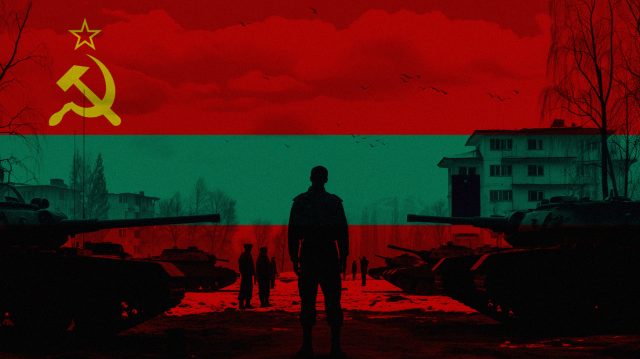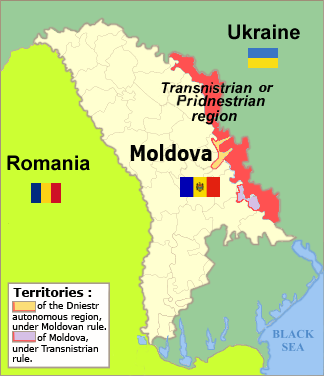
Between Moldova and Ukraine lies a region often overlooked on the global stage yet steeped in complexity and controversy. Transnistria, officially the Pridnestrovian Moldavian Republic, stands as a self-proclaimed state with ambiguous sovereignty and very strong ties to Russia. Now, it is looking to solve its own identity crisis by formally uniting with “the motherland”.
A brief history of the “Republic”
The origins of Transnistria’s identity crisis trace back to the dissolution of the Soviet Union. As the USSR disintegrated in 1991, Moldova declared independence, but Transnistria, populated predominantly by ethnic Russians and Ukrainians, resisted integration into the new Moldovan state. A brief but bloody conflict ensued, leading to a ceasefire in 1992. Since then, Transnistria has functioned as a de facto independent entity, yet unrecognized by the international community.

Despite lacking international recognition, it operates its own government, military, and institutions, showcasing a semblance of statehood. However, its political legitimacy remains contentious, with Moldova asserting its territorial integrity and sovereignty over the region.
What prevents the legitimate Moldovan state from taking back said territory is an official battalion of the Russian army, the 14th, to be precise, guarding Transnistria since the aforementioned ceasefire. Without the support of NATO, and lacking a strong military of its own, Moldova had no choice but to wait and hope the major players on the international stage will sometime, somehow, someway, resolve this issue.
Years passed and Trasnistria remained a geopolitical puzzle. But all that may be on the verge of changing…
What are they up to?
Moldavian intelligence and transnistrean activists in favor of reunification with Moldova have issued warning in the last week that the authorities in Tiraspol (capital of this breakaway “republic”) are preparing their biggest strategic move yet – the final purpose being none other than their complete assimilation into the Russian Federation.
An extraordinary gathering of what are referred to as representatives at various levels from Transnistria, slated for February 28, is anticipated to make a formal appeal to Moscow regarding the potential integration of the separatist region into the Russian Federation, as conveyed by Transnistrian dissenter Ghenadie Ciorba to Deschide.md. Instances of such assemblies, which have brought together all elected officials from Transnistria, have been very rare, occurring only twice in history: in 1990, when they proclaimed the autonomous but internationally unrecognized separatist republic, and in 2006, in response to allegations of an economic blockade by Chisinau.
Ciorba highlights the timing of the assembly in Tiraspol, which coincides with the scheduled address of Russian President Vladimir Putin to the Federal Assembly. According to him, the forum of Transnistrian representatives is expected to witness the launch of a formal request from residents of the region’s left bank for annexation to the Russian Federation. Subsequently, on February 29, Putin would reportedly announce this development to the Federal Assembly, which would then deliberate on whether to endorse the request.
Should the pro-Russian authorities in Tiraspol proceed with such a course of action, it could heighten tensions in the longstanding conflict in Transnistria, providing a possible pretext for military intervention by the Kremlin. Historically, Russia has cited similar justifications for armed interventions in territories such as Georgia, Crimea, and Ukraine.
The Institute for the Study of War (ISW), a well-known and respected think-tank in such matters, also issued a public warning on the events that may transpire by the end of this month, signed by their senior editors George Barros, Fredrick W. Kagan, Christina Harward, and Angelica Evans.
Additionally, the concerns voiced by various sources recently are not merely rooted in casual discussions or hearsay. The self-proclaimed republic has established the necessary legal structures in the past to pursue integration into the Russian Federation. Since 2006, Transnistria has formally expressed its desire for annexation to Russia. In 2006, a referendum was held in Transnistria in favor of joining the Russian Federation, while rejecting a referendum on reunification with Moldova. In January 2023, President Vadim Krasnoselsky of Transnistria reiterated the region’s ongoing commitment to implementing the referendum from 2006 regarding accession to Russia.
Furthermore, ISW assesses that this strategical evolution could provide the Russian Federation with a platform to exercise hybrid warfare on the almost defenseless Republic of Moldova, through a very diverse number of means, ranging from the cyber domain to real-life operations.
Ukraine is skeptical to the information
The Ukrainian Defense Intelligence Service has reported that representatives from the unacknowledged Transnistrian republic do not plan to petition President Vladimir Putin for the incorporation of the separatist region into Russia during the upcoming congress later this month, as per Ukrainska Pravda. Ukrainian authorities suggest that this speculation, currently circulating widely in the media, is a component of Moldova’s internal political dynamics and also reflects Transnistria’s efforts to safeguard its economic interests.
However, due to the geographical localization of Transnistria, it could prove to be in Ukraine’s best war-interest for the event to happen. The proximity between the most heavily guarded and enforced part of Ukraine, respectively the Odesa oblast and what could prove to be a Transnistrean theater of operations could incentives Kiev to desire a Russian annexation of the region. The following step would, of course, be the occupation of the area by the Ukrainian armed forces and the usage of it’s occupation as a bargaining chip in the international negotiations that are inevitably going to start at some point with the goal of ending the Russo-Ukrainian war. Does that sound far-fetched? It may be to Western analysts, but over the course of the war, there have been reports of discussions between advisors to Zelensky and president Maia Sandu of Moldova on a “solution” to the Transnistria problem. This month, Mrs. Sandu declared for France24 that if Kiev wins the war “an opportunity arises” for said “solution”. She did not go into many details.
However, tensions remain high in Chisinau
The Policy Bureau for Reintegration within the Government of the Republic of Moldova has issued a call to the Transnistrian authorities, urging them to exercise caution and refrain from impulsive actions. This statement from the Bureau follows reports circulating in the public sphere regarding the upcoming congress of deputies at all levels scheduled for February 28 in Transnistria, as communicated by the Bureau on the official website of the Government of the Republic of Moldova.
Stressing its vigilant monitoring of the situation in the Transnistrian region, the Bureau maintains continuous communication with the OSCE Mission and other international partners. The comment emphasizes the belief that Tiraspol is cognizant of the potential repercussions of “reckless” decisions.
Romanian government sources have revealed for G4Media (one of the leading political news websites in Romania) that President Maia Sandu of the Republic of Moldova is set to attend the upcoming congress of the European People’s Party (EPP) in Bucharest in two weeks’ time, against the backdrop of heightened tensions. The EPP congress, scheduled for March 6th to 7th, will gather all heads of state and government, along with party leaders from the EPP, alongside prominent figures such as President of the European Commission, Ursula von der Leyen, President of the European Parliament, Roberta Metsola, and all European Commissioners associated with the political bloc.
Such decisions show that the Republic of Moldova may have access to information that is kept away from the public and will attempt to rally the Western powers to its cause if the worst case scenario comes to fruition. But as in the case of Ukraine, it is still unknown what path can the European Union and/or NATO pursue, given the fact that Moldavia is not a part of either organization yet.



 Subscribe
Subscribe